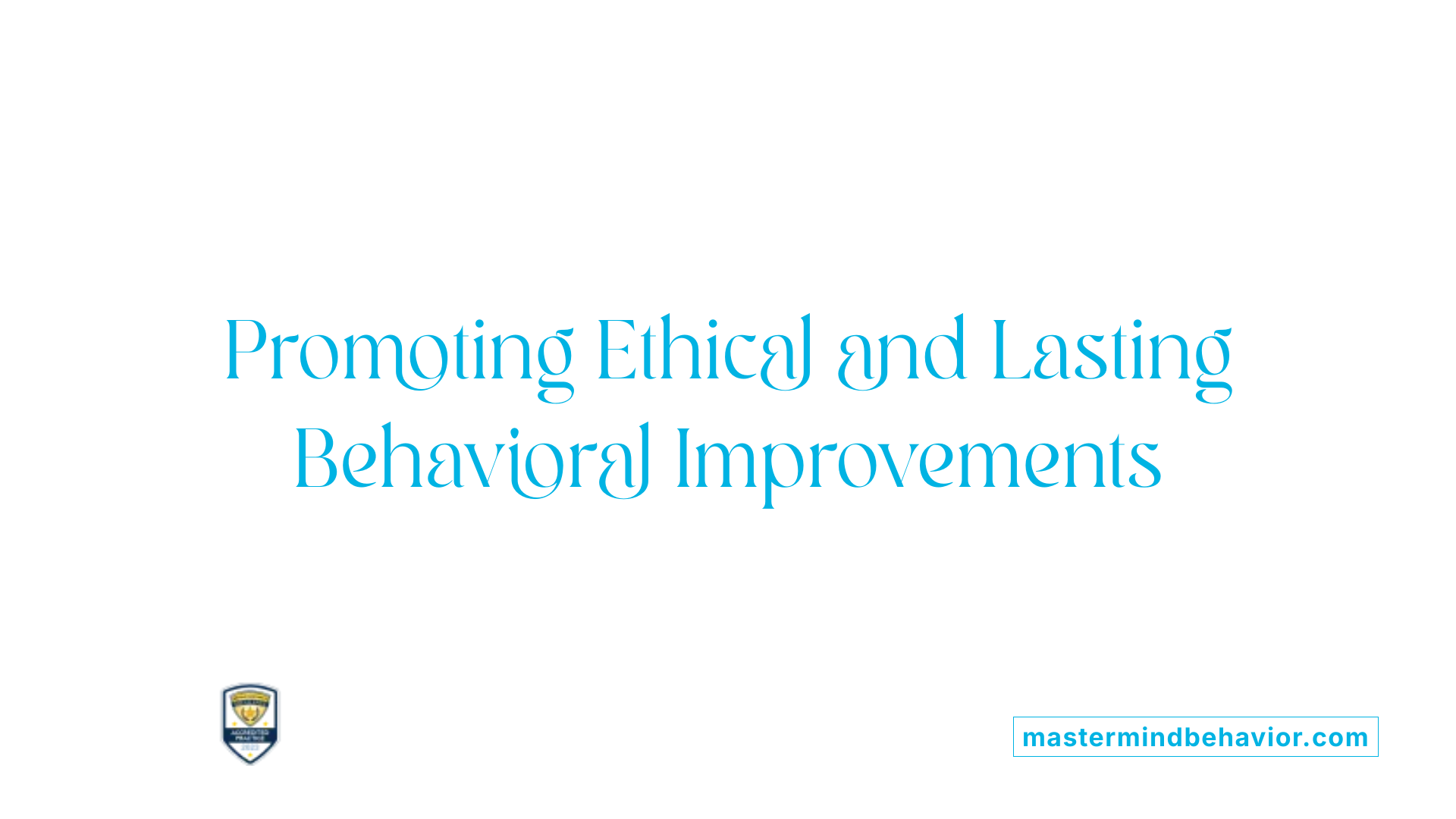How ABA Therapy Can Help with Learning to Accept “No”

Understanding the Role of ABA in Teaching Acceptance of 'No'
Learning to accept 'no' is a critical developmental milestone, especially for children with autism spectrum disorder (ASD). Applied Behavior Analysis (ABA) offers a structured, evidence-based approach to help children develop resilience, social understanding, and emotional regulation in response to refusals. This article explores how ABA therapy facilitates the acceptance of 'no' and promotes adaptive behavioral responses, contributing to overall social and developmental progress.
Core Principles and Methods of ABA for Teaching Acceptance
What are the core principles and methods of ABA therapy that facilitate teaching acceptance of 'no'?
Applied Behavior Analysis (ABA) uses specific techniques rooted in behaviorist principles to teach children how to accept and respond to refusals or 'no' in a more positive and adaptive manner. These methods focus on reinforcing desirable responses, shaping behaviors, and gradually increasing the child's acceptance of social boundaries.
One fundamental aspect is reinforcement. Positive reinforcement involves adding a pleasant stimulus after a desired behavior to increase its future occurrence. For example, praising a child after they accept a refusal can help them learn that tolerating 'no' results in positive outcomes. Conversely, negative reinforcement involves removing an aversive stimulus to encourage a behavior, such as allowing a child a break when they request it appropriately, which helps them communicate needs instead of reacting negatively.
Prompting and shaping are also core techniques. Prompting provides initial guidance, like verbal cues or gestures, to help children respond correctly, while shaping involves reinforcing successive approximations of accepted behavior. Over time, these methods gradually reduce prompts and foster independent, appropriate responses to refusals.
Differential reinforcement plays a crucial role in reducing challenging behaviors associated with denial or rejection. By reinforcing alternative, acceptable behaviors—such as asking politely or using functional communication—while withholding reinforcement for negative reactions or tantrums, children learn to cope with 'no' more effectively.
Incorporating acceptance-oriented strategies from Acceptance and Commitment Therapy (ACT) enriches ABA approaches. ACT emphasizes acceptance of difficult thoughts and feelings, mindfulness, and aligning actions with personal values. Techniques such as defusion (distancing from negative thoughts) and present-moment awareness help children tolerate emotional discomfort associated with refusals, reducing avoidance and escalation.
By blending behavioral techniques with acceptance strategies, ABA creates a comprehensive approach that promotes emotional regulation, resilience, and social understanding. Children become better equipped to interpret refusals not as punishments but as natural parts of social interaction, leading to more adaptive and confident responses.
How do these ABA methods support children in accepting 'no'?
Through consistent application of reinforcement, prompting, shaping, and acceptance strategies, children gradually develop tolerance for being told 'no.' Reinforcement encourages adaptive responses, while shaping moves them towards independence in handling refusals. Acceptance skills foster psychological flexibility, reducing resistance and negative reactions.
Ongoing data collection and progress monitoring help therapists tailor interventions, ensuring that children acquire these skills effectively. Family involvement further strengthens the child's ability to generalize acceptance skills across different settings, promoting long-term development.
In sum, ABA's integration of behavioral techniques with acceptance-based principles offers a robust framework to help children accept 'no' in a functional, respectful, and socially meaningful way.
Use of Reinforcement Strategies to Promote Acceptance

How does ABA therapy help children learn to accept 'no' and develop resilience?
ABA therapy plays a vital role in teaching children to accept refusals or 'no' and build resilience through strategically designed reinforcement techniques. One of the primary approaches involves using positive reinforcement, such as praise, rewards, or preferred activities, to encourage children to respond calmly and appropriately when they hear 'no.' This method makes the experience less stressful and more manageable for the child, promoting a positive association with limits.
Negative reinforcement also supports this learning process. For example, when a child's demands are temporarily removed or reduced after requesting a break, they learn that expressing needs calmly can lead to avoiding or reducing unpleasant stimuli. This technique encourages children to communicate their needs effectively instead of reacting negatively to denial.
A foundational aspect of fostering acceptance is teaching functional communication skills. Children are guided to use verbal and non-verbal methods, such as picture exchange systems (PECS), sign language, or AAC devices, to express themselves. This reduces frustration and provides them with more appropriate ways to communicate their needs and boundaries.
To systematically develop these skills, ABA practitioners utilize the ABC analysis (Antecedent, Behavior, Consequence). This framework helps identify triggers and outcomes related to refusals, enabling tailored interventions that address specific challenges.
Advanced strategies like the Turn Autism Around Approach and Dr. Vincent Carbone's shush-and-give procedure teach children to tolerate limits gently. These methods often involve calming the child first and then offering alternatives, reinforcing patience and resilience.
Daily practice across different settings—including therapy sessions, home, and school—ensures consistency and generalization of skills. Clear expectations are communicated during these practices, helping children understand and accept boundaries in various contexts.
Ongoing data collection is crucial to monitor progress and refine interventions. By regularly tracking responses and behaviors, therapists can adjust strategies to align with each child's evolving needs.
Throughout the process, respect, kindness, and dignity are central to ABA practices, fostering a supportive environment where children feel safe to explore and accept 'no.' In conclusion, ABA's reinforcement strategies, combined with teaching functional communication and behavior analysis, effectively promote children’s acceptance of refusals and cultivate resilience that benefits them throughout their lives.
Behavioral Strategies for Managing Challenges with Refusals
What behavioral strategies are used in ABA therapy to manage challenges related to accepting refusal?
In ABA therapy, several proven strategies are employed to help children accept refusals and develop patience. Central to these are reinforcing positive behaviors, teaching waiting skills, and applying differential reinforcement and extinction techniques.
Reinforcing positive behaviors involves praising and rewarding children when they respond appropriately to 'no' or delays. This encourages the repetition of acceptable responses and reduces problematic reactions. For example, a child who tolerates a refusal without tantrums earns praise or a preferred item, strengthening their understanding that patience pays off.
Teaching waiting and patience is another core component. Therapists utilize techniques like structured waiting periods and visual cues to help children understand the concept of delayed gratification. Over time, children learn to wait calmly for access to desired items or activities.
Differential reinforcement involves reinforcing alternative, appropriate behaviors while withholding reinforcement for undesired responses. For instance, instead of reacting negatively when told 'no,' a child is encouraged to use their words or respond calmly. Extinction methods are also used to reduce inappropriate behaviors by consistently ignoring or withholding reinforcement when such behaviors occur.
Gradual exposure and modeling are effective for fostering acceptance. Children are gradually introduced to situations where refusals happen more frequently, paired with modeling desired responses by therapists or peers. Role-playing, social stories, and video modeling help children internalize appropriate reactions to refusals.
Dr. Mary Barbera's structured 'Turn Autism Around' approach emphasizes the importance of a systematic process—assessment, planning, teaching, and data collection. This ensures that each child's unique needs are addressed while fostering their ability to accept 'no' and wait patiently.
One specific technique adapted from Dr. Vincent Carbone is the 'shush and give' procedure. This method involves calming interventions where caregivers quietly signal a pause, helping children manage frustration and accept limited access to preferred items.
Prevention strategies play a crucial role as well. Providing children with multiple opportunities to request items (manding) and teaching them to tolerate delays through engaging in alternative activities help prepare children for real-life situations involving refusals.
Consistency across environments, positive reinforcement, modeling, and gradual exposure form the backbone of these behavioral strategies, helping children develop better acceptance of 'no' within ABA frameworks.
Efficacy of ABA in Teaching Acceptance and Behavioral Response Management

How effective is ABA therapy in addressing behavioral responses to 'no' and teaching acceptance?
Applied Behavior Analysis (ABA) has been extensively studied and proven effective in helping children, especially those with autism spectrum disorder (ASD), improve their responses to social boundaries such as being told 'no.' Research reviews and meta-analyses highlight that ABA interventions can significantly reduce challenging behaviors like tantrums, aggression, and defiance, which often occur when a child is denied a request or boundary.
One of the core strengths of ABA is its focus on reinforcing appropriate responses through positive reinforcement. When a child learns to respond calmly or accept rejection, therapists typically use reward systems, praise, or functional communication methods to encourage these behaviors. Over time, children become more tolerant of 'no' and other refusals, which contributes to better social integration and emotional regulation.
Studies show that early intervention plays a crucial role in the success of ABA strategies. For children between the ages of 2 and 6, intensive ABA programs can lead to substantial improvements in language, social skills, and adaptive behaviors. These early gains often carry into later childhood and adolescence, supporting long-term development.
The effectiveness of ABA isn't limited to a specific age group; it can be tailored to individuals of varying developmental levels. Nevertheless, evidence suggests that the greatest benefits are observed when interventions begin early in life, as the neuroplasticity at young ages offers a window of maximal learning potential.
Overall, ABA stands as a scientifically validated approach with a robust evidence base supporting its use for teaching acceptance of social boundaries and improving behavioral responses. Its practical, data-driven methods empower children to handle complex social situations more adeptly, fostering independence and resilience in navigating everyday interactions.
Supporting Social Boundaries and Developmental Milestones

How does ABA therapy support learning to accept social boundaries and complete developmental milestones?
ABA (Applied Behavior Analysis) therapy plays a crucial role in helping children understand and accept social boundaries while reaching important developmental milestones. This evidence-based approach uses structured techniques such as discrete trial training, role-playing, and social stories to teach essential social skills.
One of the primary methods involves breaking down complex social behaviors into manageable steps. For example, children learn about personal space through gradual exposure and reinforcement, gradually understanding when to maintain or respect physical boundaries.
Responding appropriately to social cues—like facial expressions, body language, and tone of voice—is another focus. Therapists use visual aids and modeling to help children recognize and interpret social signals correctly. Reinforcement strategies motivate children to imitate and respond to these cues, fostering social awareness.
Following social rules and expectations is taught through direct instruction and practice. Children are guided on appropriate manners, turn-taking, sharing, and other social norms, often reinforced through praise and rewards. These behaviors are practiced in various contexts, including one-on-one and group settings.
Generalization of skills across different environments is vital for lasting learning. ABA interventions incorporate naturalistic teaching methods, such as peer-mediated activities and community-based practices, to ensure children can apply skills beyond therapy sessions. This might include playing cooperatively during recess or following rules in a classroom.
Ongoing assessment helps tailor interventions to each child's progress, ensuring that goals remain relevant and personalized. Therapists and parents work together to set achievable targets, monitor advances, and adjust tactics accordingly.
Overall, ABA fosters a comprehensive understanding of social boundaries, improves communication skills, and supports developmental milestones. This approach empowers children to navigate social interactions confidently, build relationships, and integrate successfully into society.
Behavioral Skills and Boundary Recognition in ABA
How does ABA therapy support the development of behavioral skills related to acceptance of limits and boundaries?
ABA therapy plays a crucial role in helping individuals, particularly children with autism, learn to recognize and respect social and physical boundaries. This targeted intervention uses a variety of strategies to teach appropriate responses to limits, fostering better social interactions and personal safety.
One of the main approaches is the use of visual supports such as picture cards, social stories, and schedules. These tools help clarify what behaviors are acceptable in different situations and increase understanding of social cues and personal space. For example, social stories can depict scenarios where respecting others' boundaries is necessary and reinforce positive behavior.
Modeling and role-playing are also integral to ABA methods. Therapists demonstrate appropriate boundary-respecting behaviors, and children practice these skills through simulated interactions. This hands-on practice enables learners to internalize the concepts of acceptable behavior and develop confidence in applying them outside therapy sessions.
Positive reinforcement is used to encourage boundary-appropriate actions. When a child correctly respects a limit—such as stopping when told to wait or refraining from touching something they shouldn’t— they receive praise, tokens, or other preferred rewards. Repeated reinforcement helps these behaviors become consistent and automatic.
Monitoring progress is vital to tailoring effective interventions. Data collection throughout therapy sessions provides insights into how well a child is recognizing and respecting boundaries. These records help clinicians adjust strategies, ensuring that skills generalize across settings and situations.
In sum, ABA therapy systematically teaches recognition of personal and social boundaries, promoting respectful and safe interactions. It combines visual supports, modeling, role-playing, and positive reinforcement, all guided by ongoing data to foster meaningful behavioral improvements.
Fostering Skill Generalization and Family Involvement

How does ABA therapy support learning to accept social boundaries and complete developmental milestones?
ABA therapy plays a vital role in helping children recognize and respect social boundaries while achieving important developmental milestones. By systematically teaching social skills—such as understanding personal space, interpreting social cues, and following social norms—ABA methods facilitate meaningful social interactions.
Evidence-based techniques like discrete trial training, role-playing, and social stories are commonly used to reinforce these skills. For example, a child may participate in role-playing scenarios that simulate real-life social situations, where they practice responding appropriately to personal space or social greetings. Reinforcement strategies, such as praise or tokens, are employed to encourage correct responses and internalize appropriate behaviors.
To promote naturalistic learning and enhance ecological validity, ABA programs integrate peer-mediated activities and community-based practices. This approach ensures that children generalize their skills beyond the clinical setting and apply them successfully in everyday life.
Regular assessment and tailored goal setting are essential components. These strategies allow therapists to fine-tune interventions, focusing on relevant social boundaries and developmental milestones. The ongoing process ensures children not only learn social skills but also confidently navigate social interactions, build relationships, and participate fully in their communities.
In addition to direct teaching, family involvement is crucial. Parents and caregivers receive training to reinforce social boundaries and milestones at home and in other environments. Consistent practice across different settings helps solidify learned skills, leading to sustained progress.
Monitoring data collection informs progress, allowing for adjustments that maximize developmental gains. Ultimately, ABA supports children in understanding social expectations, developing communication, and forming meaningful social connections—foundations for lifelong social and emotional well-being.
Long-term Benefits and Ethical Practice in ABA

What role does ABA therapy play in improving behavioral skills related to acceptance of limits and boundaries?
ABA (Applied Behavior Analysis) therapy is instrumental in helping individuals, particularly children with autism, learn to accept boundaries and social limits. It employs structured strategies such as visual supports, social stories, modeling, and role-playing to teach respectful behaviors and awareness of personal space.
One core approach involves using positive reinforcement to encourage boundary-appropriate actions. For example, when a child respects a physical limit or responds appropriately to social cues, they receive praise or preferred activities as rewards. This consistent reinforcement helps generalize these behaviors across different environments, reducing incidents of boundary violations.
ABA therapists carefully collect data to measure progress, allowing for individualized adjustments. This tailored approach ensures that each child’s unique needs and developmental stage are considered, fostering genuine understanding and acceptance of limits.
Building trust and rapport is another vital aspect of ABA interventions. When children feel safe and supported, they are more receptive to learning boundaries and social norms. Techniques like modeling desired behaviors and guiding children through real-life scenarios increase their confidence in navigating social boundaries independently.
Overall, ABA creates a structured, personalized system that promotes ethical and respectful acceptance of boundaries. By fostering understanding and consistent practice, it empowers individuals to interact confidently within social limits, improving their social integration and emotional regulation.
Empowering Children for a Resilient Future
ABA therapy offers a comprehensive and scientifically supported framework for helping children learn to accept 'no' and develop resilience to limits. By combining reinforcement, structured techniques, social skills training, and ongoing data collection, ABA cultivates adaptive responses, emotional regulation, and social understanding. This holistic approach not only reduces challenging behaviors but also equips children with essential life skills that foster independence, confidence, and positive social interactions. When implemented with compassion, consistency, and family involvement, ABA has the potential to empower children to face social boundaries with resilience and dignity, laying a foundation for lifelong success.
References
- 10 Common ABA Therapy Techniques
- Key ABA Therapy Milestones: What Progress Looks Like
- Key Life Skills Taught in ABA Therapy for Kids
- What Parents Need to Know About ABA Therapy for Autism
- ABA and ACT - Insight
- ABA Therapy: The Ultimate Guide - Autism Learning Partners
- The Controversy Around ABA - Child Mind Institute
- Debunking 7 Common Myths About ABA Therapy - GSEP Blog
Recent articles

ABA Therapy For Building Self-Regulation And Coping Skills
Harnessing ABA Therapy to Empower Emotional and Behavioral Mastery in Autism

ABA Therapy For Building Skills In Independent Decision Making
Empowering Autistic Individuals Through ABA: A Pathway to Autonomy

Collaborative Communication Between Therapists and Families
Building Bridges: The Essential Role of Collaboration in Autism Therapy

How ABA Helps Develop Adaptive Behavior Skills Over Time
Unlocking Independence: The Role of ABA in Building Adaptive Skills

The Role of Parent Priorities in Designing ABA Goals
Collaborative Goal-Setting: Aligning ABA Therapy with Family Priorities

Translating ABA Goals into Everyday Functional Skills
Bridging Theory and Practice: How ABA Therapy Enhances Daily Life for Individuals with Autism



